|
Water Test Results note 1
All of the tests on this page done on the filters described on this website were performed by epa certified labortories:
The City of Everett, Washington Evironmental Labortory
AmTest in Kirkland Washington
IMPORTANT:None of the water that goes through any of the filters described on this website is being used as
potable water. To do so would require that the water be tested on a regular basis for turbidity and biological contamination;
and would require the addtion of a UV filter at the point of use. The water is being used for irrigation and cleaning without
any further filtering.
We have found that if water from this roof is not filtered, it will go horrificly stagnant in the summer. None of the water that
has gone through any of the filters here has ever gone stagnant in the 8 years we have been running the filters. The roof at this location
is surrounded by trees. We are deep in the forest. There are lots of sources of biological contamination here, that may not be present at another location without trees and abundant wildlife.
THE TESTS TELL US WHAT HAS BEEN REMOVED FROM THE WATER.
THE TESTS DO NOT TELL US WHAT MAY BE IN THE WATER. Anything can be in water.
This is the first test of filter 2 received in May. The filter has not fully developed the biological layer.
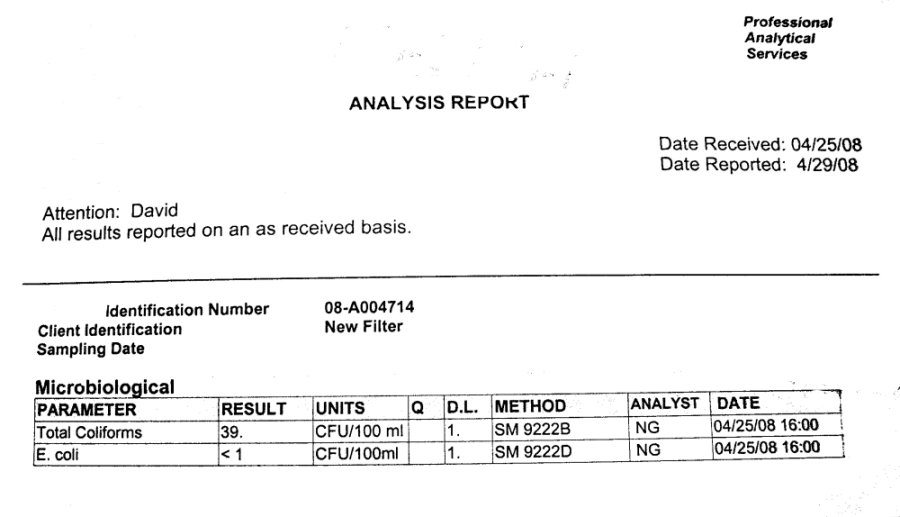
This is the second test of filter 2 (new filter) received on June 3, 2008. The new filter is now working.
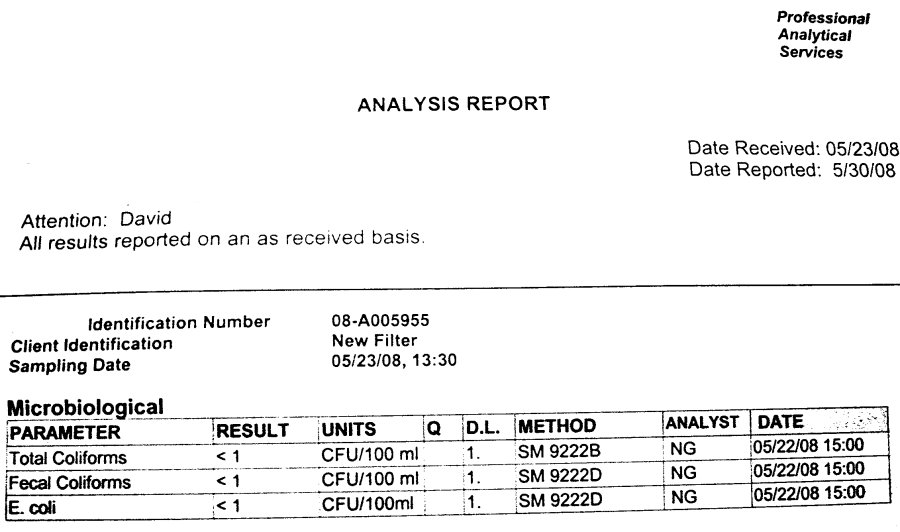
This is a test on filter 2 (new filter) in 2008
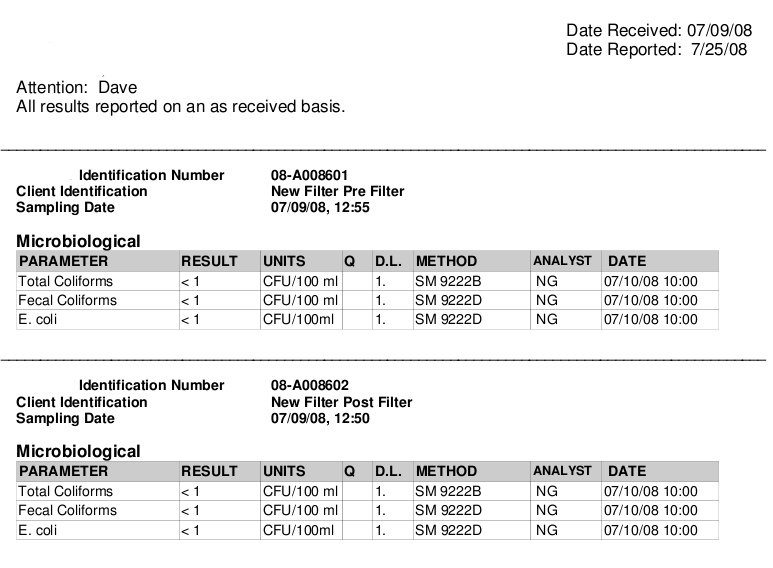
This is a test on filter 1 (old filter) in 2008
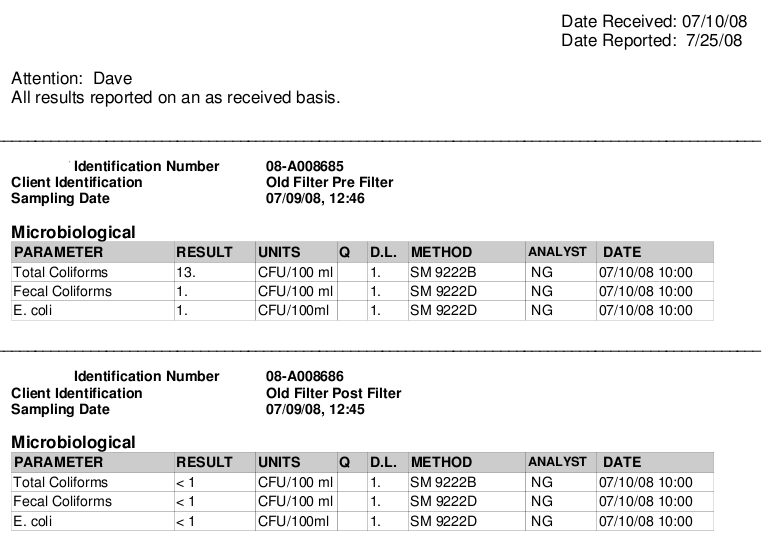
Below is the first test result on filter 3 This is the first test on filter 3 which uses with AWWA / NSF approved sand
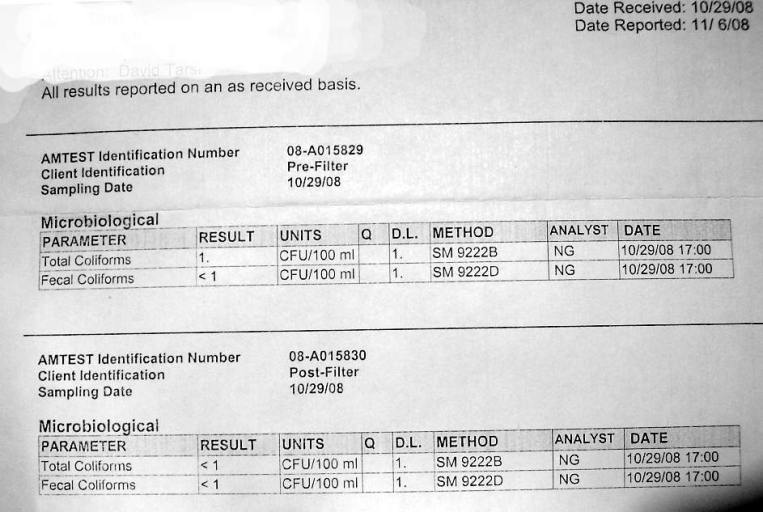
Below are the test results from the original filter (filter 1 also called "old filter")
Water Sample test results post-filter (filter 1) August 8 2007. BEFORE the .15mm sand was added.
Not using a first-flush diverter on the roof water source.:
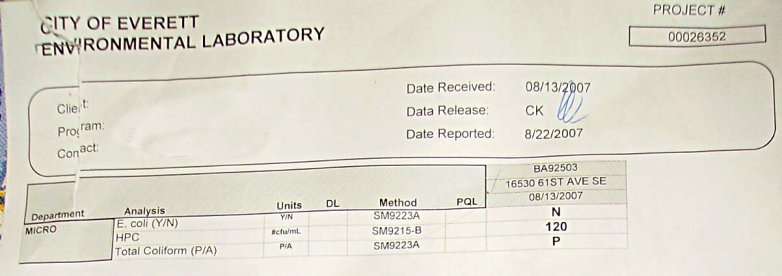 Water sample tests pre-filter and post-filter (filter 1) Oct. 18 2007. AFTER the .15mm sand was added. Not using a first flush diverter on the roof water source. 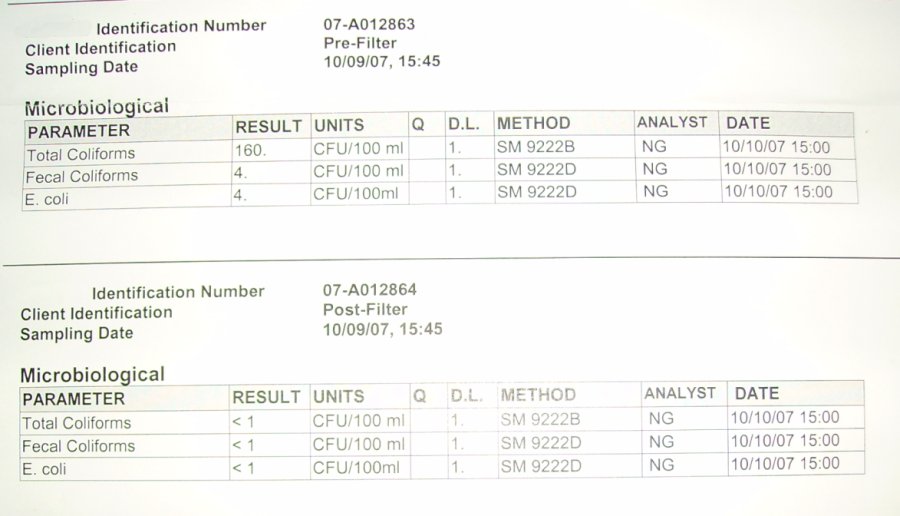 Water sample tests pre-filter and post-filter (filter 1) for Feb 2008. AFTER the .15mm sand was added. Using a first-flush diverter on the roof water source, and the recirculating pump system wherein raw water is added once a day in amounts less than 5 gallons, with as many as 3 consecutive days where no raw water is added and temperatures are at or below freezing (32 degrees F) 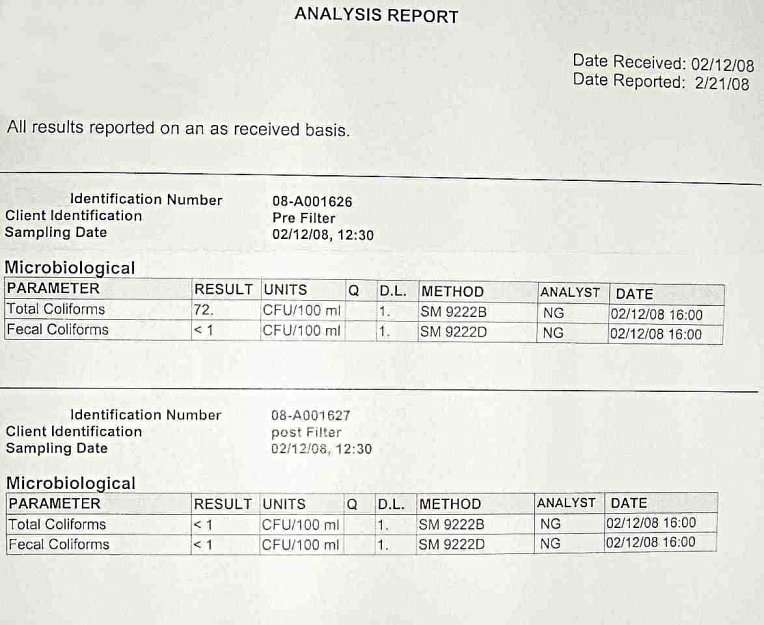 Below are the tests on the "old filter" also called filter 1 in conjunction with the first flush diverter. These include the tests that show how much petroleum pollution comes from this compostion roof and how much is removed. back to Building a small slow sand water filter for individual use 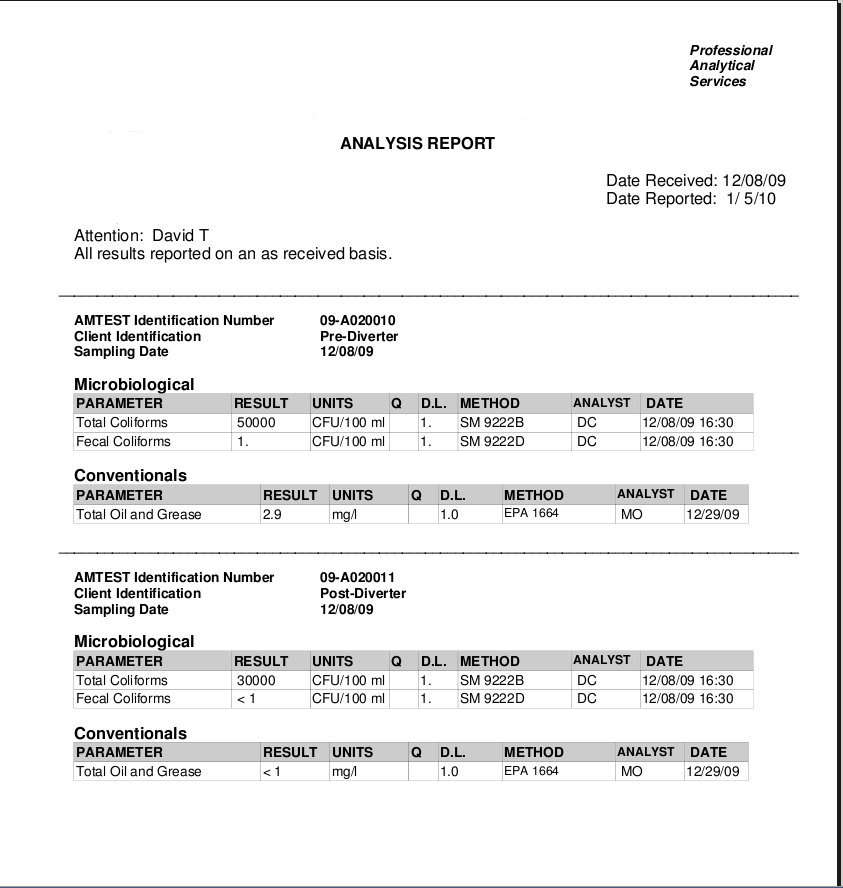 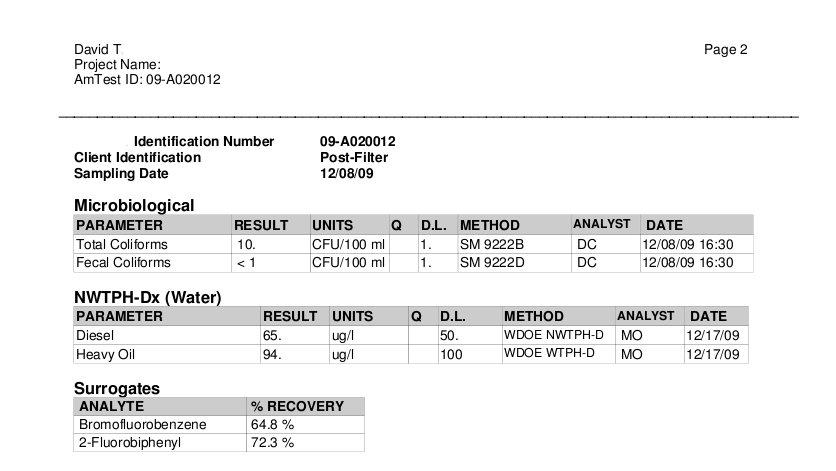 Below are the most recent tests on filter 1 showing Total Organic Carbon removal, and compliance with the Snohomish county requirements: The test shown below shows that filter 1 produces water that passes the Snohomish county requirements for levels of pollutants present. And also passes the epa requirements, which are essentially the same as the Snohomish county requirements.  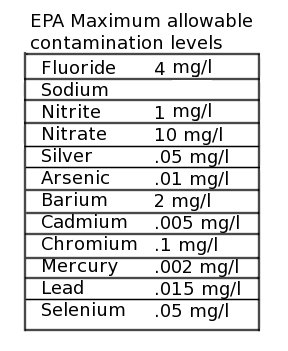  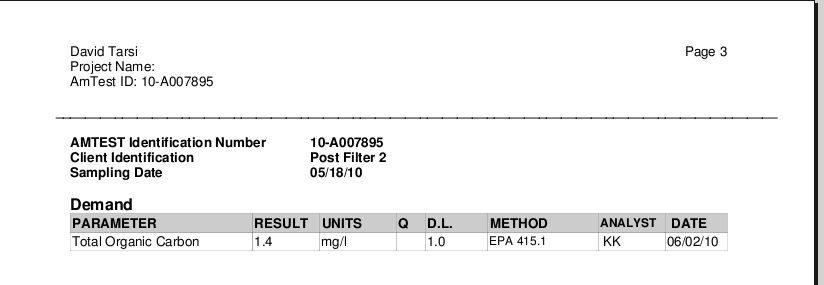 Below are the Pond filter (filter 6) coliform test results and turbidity test results: 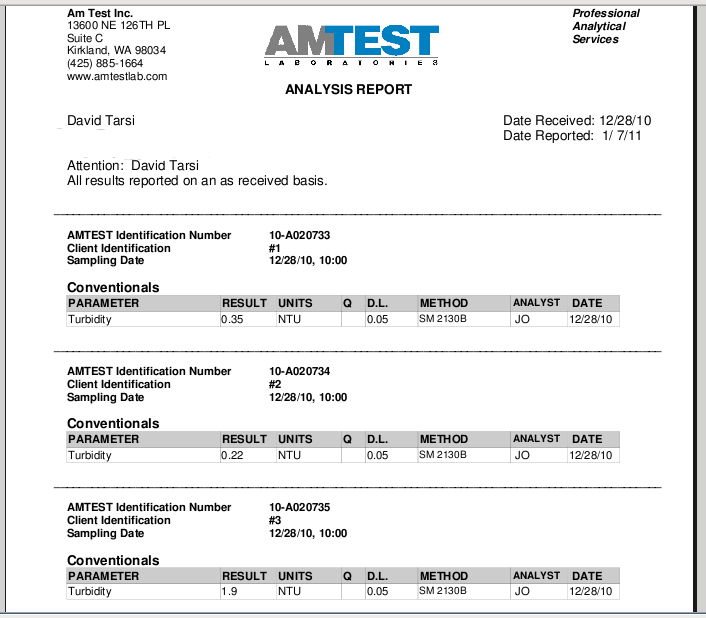 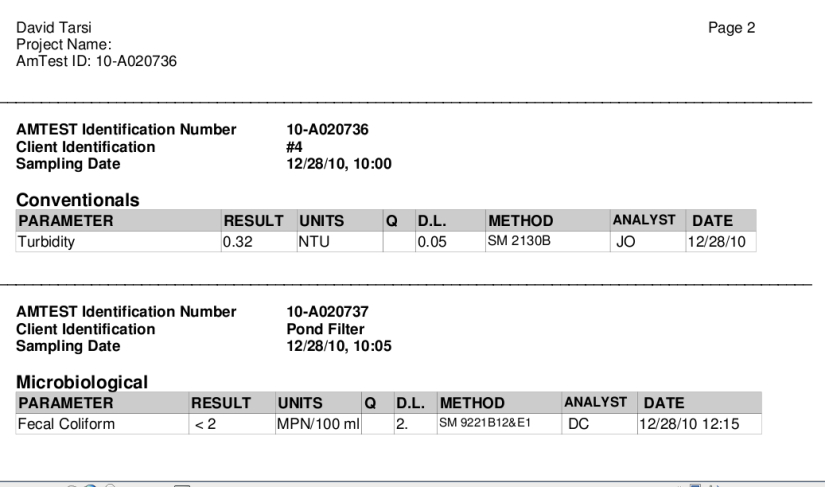 So far, what conclusions can we draw from all of the test results? Most importanly THESE TESTS DO NOT PROVE THAT THE WATER FROM THESE FILTERS IS SAFE TO DRINK IN ALL CASES. Only E Coli, Fecal coliform, coliform bacteria, and petroleum hydrocarbons have been shown to be removed by filter 1 in this situation, and filter 2 and 3 have not been tested for petroleum hydrocarbon removal. However the most recent test on filter 1 does show that the output water passes the EPA test and the local county test for safe drinking water by comfortable margins. Also note that water from different areas may contain different substances. 1.The tests show all coliform bacteria are removed: E Coli, Fecal coliform, and coliform in the filter design with .15mm sand added. 2. The addition of the first flush diverter and/or the cold weather, or a combination of cold weather, more water, and the diverter have (apparently?) reduced (but not eliminated) the amount of coliform bacteria in the water taken from this roof. 3. The biological activity of the filter does not completely stop in weather at near freezing temperatures; and after several days of inactivity while frozen, the functionality of this filter, in this situation, was not adversely effected. 4. A first flush diverter will not safely remove all bacteria from water taken from this roof. 5. Near freezing temperatures will not eliminate all coliform bacteria from the water taken from this roof. 6. It is not safe to consume unfiltered/unpurified water taken from this roof even though there is a diverter in the system. 7. From a bacteriological standpoint, the water from this slow sand filter is safe to consume in summer temperatures, fall temperatures and winter temperatures in this area - providing the filter is properly operated and maintained, and not completely frozen. 8. We do not know the nature of all chemical pollution of the water from this filter. 9. With respect to chemical pollution other than petroleum hydrocarbons, more filtering/testing would be necessary to confirm that the water from this filter / supply system is safe to consume over long periods of time. 10. With regard to health, it is prudent to err on the side of caution and assume that water from a roof is not safe to drink without filtering and testing. 11.Based on the above tests, We do not know with certainty what viruses are present or not present in the post-filter water. 12.Since coliform bacteria are removed, viruses called "Phages" or "Bacteriophages" that occupy coliform may also removed; but we do not know for sure. 13.Since the test for pathogens did not specifically include tests for all viruses; if the water is to be used on a regular basis for drinking, the use of a uv filter is highly recommended. 14.Coarse sand is not as effective as fine sand in the removal of bacteria in the filters tested here. 15.Some of the pre-filter samples do not contain large enough amounts of coliform bacteria to aggressively challenge filter 2 and filter 3. 16.A slow sand filter will remove petroleum hydrocarbon pollutants from roof water runoff taken from the roof in ths study. 17.A first flush diverter will also remove petroleum hydrocarbon pollutants from the same water. 18.This slow sand filter still works in freezing temperatures (0 deg C). 19.The system in this study will improve the quality of roof water from this roof to exceed class AA standards for coliform bacteria presence by a factor of 5. 20.The numbers of coliform in roof water from the roof in this test can vary considerably, from none present, to thousands present. 21.The slow sand filter does not accumulate and pass on to the output water a significant amount of the hydrocarbons that are present in the input water that has been flowing through it daily for 2 years, however it does not remove them completely. 22.The reduction of the level of hydrocarbons from the input to filter 1 (TPH - Total Petroleum Hydrocarbons) present in filter 1 output water exceeds any US EPA standards now set for TPH contamination in ground water. 23. The filters should be cleaned at least once a year; as total organic carbon increases as the schmutzdecke ages. 24. Lead and Mercury from this composition roof are not present in the output water. 25. Total Organic carbon in the output water is reduced considerably by filter 2 and filter 3. 26. The water collected from this composition roof and run through the slow sand filter system of filter1 meets the Snohomish county requirments for drinking water purity by comfortable margins. 27. Only filter 1 has been sufficiently challenged by large numbers of microbes, and successfully removed them. Although there is a preponderance of research documenting capabilites of pathogen removal far beyond what has been shown in these results; with respect to potable water, one cannot safely make the assumption that these filters will work well beyond the parameters shown here. 28. The pond filter keeps water free of fecal coliform bacteria. 29. The red laser "visual test" is not accurate as a scientific quantifiable indicator of turbidity levels, but does give a general indication of turbidity over 1 ntu. 30. A slow sand filter will produce water that passes turbidity tests required for drinking water purity, and will make water clear enough to be used with a UV light water sterilization process. (less than 1 ntu) NOTE 1: WARNING! Racoons carry parasites in their digestive systems (Baylisascaris procyonis) often called racoon roundworms, that are usually harmless to the racoons. These roundworms each produce millions of eggs which can persist in the environment for years and can cause serious illness in people. Chlorine, alcohol or ozone will not kill them.43, 44, 45, 46 Rooftops may be contaminated by these parasites' eggs if there is a racoon latrine on the roof, and rainwater may pick them up and deposit them in rainbarrels. Even though a functioning slow sand filter should remove these eggs, (they are larger than 50 microns) this study has not tested for the removal of these parasites' eggs. |
|||
| back |
|
|

This work is licensed under a Creative Commons Attribution-ShareAlike 2.5 License. terms of use
